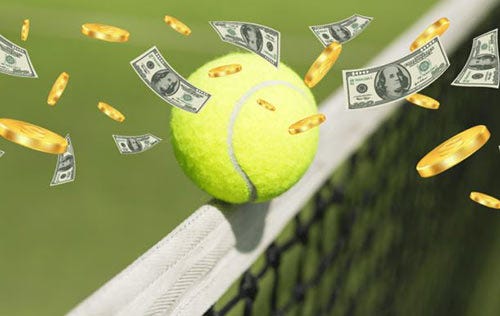Tips for Betting on Tennis – Tennis is one of the most popular sports to bet on globally, and with tournaments running for about nine months out of the year, there’s no shortage of chances to place your bets. If you’re new to it, a good way to start is by betting on the winner of one of the four major tournaments: Wimbledon, the US Open, the French Open, and the Australian Open. You’ve probably heard of top players like Andy Murray, Novak Djokovic, Rafa Nadal, Roger Federer, Serena Williams, and more.

Let’s break down how tennis betting works and explore some of the different markets available.
Understanding Tennis Scoring
Tennis matches are made up of sets and games. Each player takes turns serving, and a game is won by the first player to score four points, progressing through 0, 15, 30, and 40. If both players reach 40, it’s called deuce, and a player needs to win two consecutive points from there to take the game.
To win a set, a player has to win six games but must be ahead by two clear games. If both players are tied at 6-6, the set goes to a tiebreaker, which is played to 7 points (again, with a two-point margin required). Most men’s tournaments are played in best-of-three sets, but Grand Slam men’s matches are best of five, while women’s matches are always best of three.
A key exception is in some major tournaments, where the final set can’t be decided by a tiebreaker. In those cases, players must win by two games to close out the match.
Tournament Outright Bets
Most tennis betting revolves around tournaments, and one of the simplest bets is to pick the outright winner. Just like in other sports, you’re betting on a specific player to win the whole tournament and take home the trophy. If you’re looking for a bit of a safety net, you can place an “each-way” bet, where bookies might pay out for players who finish in the top two.
Tennis Match Betting
This is the most straightforward type of tennis bet: picking the winner of a specific match. Tennis matches are always a two-way market—either player A wins or player B wins. You just need to decide which player you think will come out on top. Many people use tennis match bets in accumulators since the odds for individual matches can be on the shorter side.
Betting on Sets
Another common market in tennis is betting on the correct score of a match in sets. For example, you might predict that Player A will win 2-0. If Player A wins two straight sets, your bet wins; if the score is anything else, you lose.
When Is the Best Time to Go to Las Vegas to Bet on Sports?
A set is won by the first player to win six games, but remember, they must win by two clear games. If the set reaches 6-6, then it goes to a tiebreaker to determine the winner.
First Set or Next Set Betting
This is a simple bet where you predict who will win the next set or the first set. Choose Player A or Player B, and if your chosen player wins that set, you win the bet.
Over/Under Bets on Sets and Games
You can also bet on the total number of sets or games played in a match. Bookmakers will set a line, such as 2.5 sets or 30.5 games. If you think the match will go longer, you’d bet the “over.” If you think it’ll be quicker, you’d bet the “under.” For example, if you bet on over 30.5 games, there needs to be at least 31 games played for you to win.
Handicap Betting
When one player is significantly stronger than the other, bookmakers offer handicap markets to even things out. The stronger player will start with a negative handicap (e.g., -2.5 games), and the weaker player with a positive one. This makes the betting more balanced and can be applied to both sets and games.
Betting on Tiebreakers
As mentioned earlier, if a set reaches 6-6, it goes to a tiebreaker. Some bookmakers offer a simple “yes/no” market where you can bet on whether or not there will be a tiebreak in the match. These bets are often placed based on the players’ serving strength.
Double Result Betting
Double-result bets combine two outcomes, such as predicting that a player will win both the first set and the match. For this type of bet to win, both parts of the bet need to be correct—so in this case, Player A would have to win both the first set and the match.